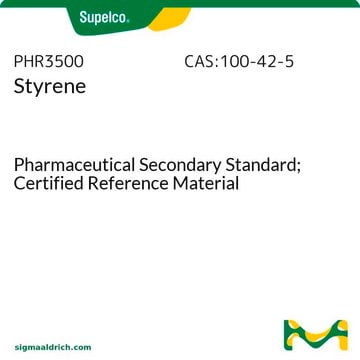47745-U
Styrol
analytical standard
Synonym(e):
Phenylethylen, Vinylbenzol
About This Item
Empfohlene Produkte
Qualität
analytical standard
Dampfdichte
3.6 (vs air)
Dampfdruck
12.4 mmHg ( 37.7 °C)
4.3 mmHg ( 15 °C)
Analysenzertifikat (CofA)
current certificate can be downloaded
Selbstzündungstemp.
914 °F
Expl.-Gr.
6.1 %
Verpackung
ampule of 1000 mg
Methode(n)
HPLC: suitable
gas chromatography (GC): suitable
Brechungsindex
n20/D 1.546 (lit.)
bp
145-146 °C (lit.)
mp (Schmelzpunkt)
−31 °C (lit.)
Dichte
0.906 g/mL at 25 °C
Anwendung(en)
environmental
Format
neat
Lagertemp.
2-8°C
SMILES String
C=Cc1ccccc1
InChI
1S/C8H8/c1-2-8-6-4-3-5-7-8/h2-7H,1H2
InChIKey
PPBRXRYQALVLMV-UHFFFAOYSA-N
Suchen Sie nach ähnlichen Produkten? Aufrufen Leitfaden zum Produktvergleich
Verwandte Kategorien
Allgemeine Beschreibung
Anwendung
Sonstige Hinweise
Signalwort
Danger
Gefahreneinstufungen
Acute Tox. 4 Inhalation - Aquatic Chronic 3 - Asp. Tox. 1 - Eye Irrit. 2 - Flam. Liq. 3 - Repr. 2 - Skin Irrit. 2 - STOT RE 1 Inhalation - STOT SE 3
Zielorgane
hearing organs, Respiratory system
Lagerklassenschlüssel
3 - Flammable liquids
WGK
WGK 2
Flammpunkt (°F)
89.6 °F - closed cup
Flammpunkt (°C)
32.0 °C - closed cup
Persönliche Schutzausrüstung
Eyeshields, Faceshields, Gloves, type ABEK (EN14387) respirator filter
Choose from one of the most recent versions:
Besitzen Sie dieses Produkt bereits?
In der Dokumentenbibliothek finden Sie die Dokumentation zu den Produkten, die Sie kürzlich erworben haben.
Unser Team von Wissenschaftlern verfügt über Erfahrung in allen Forschungsbereichen einschließlich Life Science, Materialwissenschaften, chemischer Synthese, Chromatographie, Analytik und vielen mehr..
Setzen Sie sich mit dem technischen Dienst in Verbindung.









